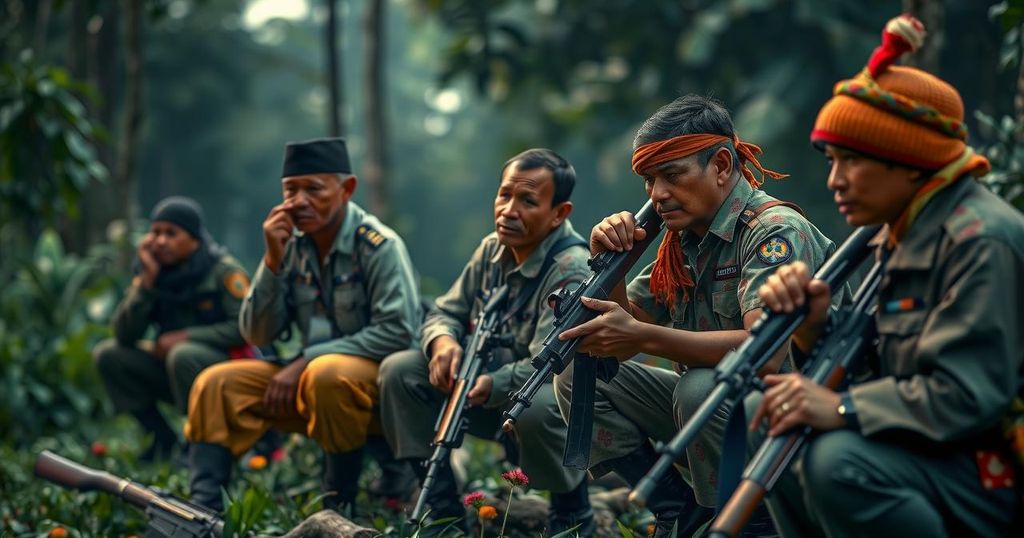Ethnic Rebels in Myanmar Announce Ceasefire and Pursue Peace Talks
The MNDAA in Myanmar has announced a unilateral ceasefire and called for talks with the military government, seeking mediation from China. The ceasefire follows recent peace overtures from the TNLA and occurs within the context of ongoing civil conflict post-2021 coup. The situation hinges on military responses and China’s strategic interests in the region, highlighting the complexities of ethnic autonomy movements in Myanmar.
In a significant development, the Myanmar National Democratic Alliance Army (MNDAA), a prominent ethnic rebel faction, has declared a unilateral ceasefire amid ongoing tensions with the ruling military government in Myanmar. This initiative aims to pave the way for peaceful negotiations with military authorities, with the potential mediation of China, which has expressed support for this initiative through its Foreign Ministry. This announcement follows an earlier commitment to peace talks from the Ta’ang National Liberation Army (TNLA), another rebel group allied with the MNDAA.
The situation in Myanmar has greatly deteriorated following the military’s coup in 2021 that deposed the democratically elected government led by Aung San Suu Kyi, leading to widespread civil unrest, armed resistance, and national discord. Both the MNDAA and TNLA have engaged in conflict over the years, seeking greater autonomy for their respective ethnic groups—the Kokang and the Ta’ang—while also forming loose coalitions with the People’s Defense Force, a notable pro-democracy group formed in response to military rule.
The MNDAA’s ceasefire declaration is particularly poignant as it comes in the wake of increasing hostilities, which previously saw these groups gaining significant territorial control along the China-Myanmar border. Although the Chinese government has historically supported actions against illegal operations in the border region, the rise in rebel strength has complicated Beijing’s relationships and regional stability concerns.
China’s previous attempts to mediate a ceasefire in January fell through in June after renewed attacks by rebel forces, which were responded to with intensified pressure from China, including border closures and electricity cuts to regions in Myanmar. Furthermore, concerns grew for the safety and interests of Chinese nationals in Myanmar, prompting foreign ministry commentary urging peaceful resolution and dialogue among factions. According to a statement from China’s Foreign Ministry, “In particular, they should not endanger the security and safety of China’s border areas, Chinese people living in the border areas and Chinese projects, companies and personnel in Myanmar.”
While the military government has yet to respond to the MNDAA’s call for a ceasefire, the group has indicated that it is ready for negotiations, wishing to resolve outstanding issues through dialogue facilitated by Chinese officials. Pending further developments, this situation represents a pivotal moment for peace negotiations in the region, affecting not only ethnic dynamics in Myanmar but also the interests of neighboring China and regional stability.
The ongoing conflict in Myanmar has deep historical roots and is exacerbated by recent political upheaval due to the military coup in February 2021, which disrupted the democratic process and incited widespread unrest. The MNDAA and TNLA, both advocating for greater autonomy, are part of a complex landscape of ethnic armed organizations often at odds with the central government. Their recent military successes have shifted the balance of power and prompted international attention, particularly from China, whose influence in the region is significant due to its political and economic ties with Myanmar. The historical grievances of these ethnic groups have contributed to a long-standing struggle for autonomy, making the prospect of negotiation and peace vital to restoring stability in the region.
The MNDAA’s declaration of a ceasefire marks a critical juncture in Myanmar’s ongoing civil conflict, emphasizing the need for open dialogue and reinforcing China’s role as a potential mediator. While responding to the complexities of ethnic demand for autonomy and military governance, the situation in Myanmar continues to draw international scrutiny. As negotiations develop, the potential for peace hinges on the cooperation of involved parties, particularly the military government’s reaction to the MNDAA’s overtures.
Original Source: apnews.com








Post Comment